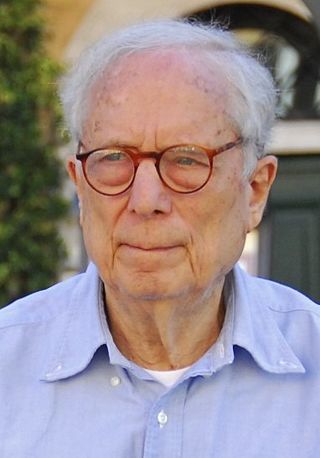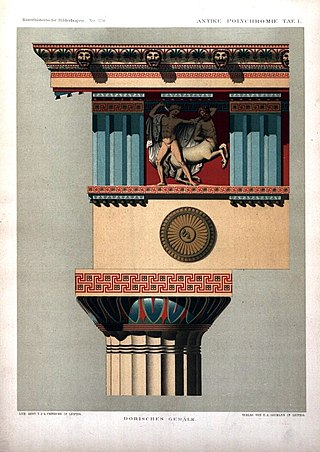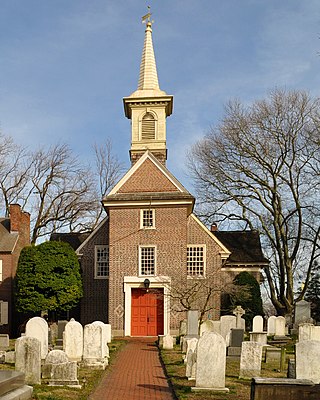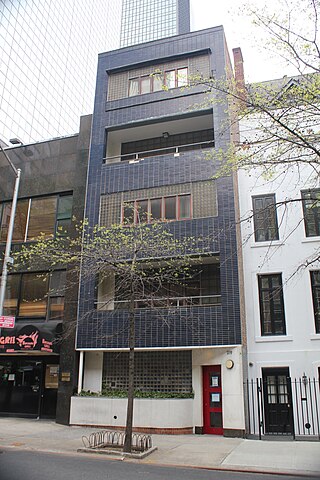
Robert Charles Venturi Jr. was an American architect, founding principal of the firm Venturi, Scott Brown and Associates.

Pediments are a form of gable in classical architecture, usually of a triangular shape. Pediments are placed above the horizontal structure of the cornice, or entablature if supported by columns. In ancient architecture, a wide and low triangular pediment typically formed the top element of the portico of a Greek temple, a style continued in Roman temples. But large pediments were rare on other types of building before Renaissance architecture. For symmetric designs, it provides a center point and is often used to add grandness to entrances.
The architecture of the United States demonstrates a broad variety of architectural styles and built forms over the country's history of over two centuries of independence and former Spanish, French, Dutch and British rule.

Postmodern architecture is a style or movement which emerged in the late 1950s as a reaction against the austerity, formality, and lack of variety of modern architecture, particularly in the international style advocated by Philip Johnson and Henry-Russell Hitchcock. The movement was introduced by the architect and urban planner Denise Scott Brown and architectural theorist Robert Venturi in their 1972 book Learning from Las Vegas. The style flourished from the 1980s through the 1990s, particularly in the work of Scott Brown & Venturi, Philip Johnson, Charles Moore and Michael Graves. In the late 1990s, it divided into a multitude of new tendencies, including high-tech architecture, neo-futurism, new classical architecture, and deconstructivism. However, some buildings built after this period are still considered postmodern.

Polychrome is the "practice of decorating architectural elements, sculpture, etc., in a variety of colors." The term is used to refer to certain styles of architecture, pottery, or sculpture in multiple colors.

The architecture of Philadelphia is a mix of historic and modern styles that reflect the city's history. The first European settlements appeared within the present day borders of Philadelphia, Pennsylvania in the 17th century with most structures being built from logs. By the 18th century, brick structures had become common. Georgian and later Federal style buildings dominated much of the cityscape. In the first half of the 19th century, Greek revival appeared and flourished with architects such as William Strickland, John Haviland, and Thomas U. Walter. In the second half of the 19th century, Victorian architecture became popular with the city's most notable Victorian architect being Frank Furness.

Sever Hall is an academic building at Harvard University designed by the American architect H. H. Richardson and built in the late 1870s. It is located in Harvard Yard in Cambridge, Massachusetts. It was designated a National Historic Landmark in 1970, recognized as one of Richardson's mature masterpieces.

The Provident Life & Trust Company is a demolished Victorian-era building in Philadelphia designed by architect Frank Furness and considered to be one of the famed architect's greatest works. A bank and insurance company founded in 1865 by members of the Society of Friends (Quakers), the Provident's L-shaped building had entrances at 407–09 Chestnut Street, which served as the entrance to the bank, and at 42 South 4th Street, which was the entrance to the insurance company. The two wings were eventually consolidated into an office building, also designed by Furness, at the northwest corner of 4th and Chestnut Streets.

Architecture is the art and technique of designing and building, as distinguished from the skills associated with construction. It is both the process and the product of sketching, conceiving, planning, designing, and constructing buildings or other structures. The term comes from Latin architectura; from Ancient Greek ἀρχιτέκτων (arkhitéktōn) 'architect'; from ἀρχι- (arkhi-) 'chief', and τέκτων (téktōn) 'creator'. Architectural works, in the material form of buildings, are often perceived as cultural symbols and as works of art. Historical civilisations are often identified with their surviving architectural achievements.

Mathematical tiles are tiles which were used extensively as a building material in the southeastern counties of England—especially East Sussex and Kent—in the 18th and early 19th centuries. They were laid on the exterior of timber-framed buildings as an alternative to brickwork, which their appearance closely resembled. A distinctive black variety with a glazed surface was used on many buildings in Brighton from about 1760 onwards, and is considered a characteristic feature of the town's early architecture. Although the brick tax (1784–1850) was formerly thought to have encouraged use of mathematical tiles, in fact the tiles were subject to the same tax.

The Vanna Venturi House, one of the first prominent works of the postmodern architecture movement, is located in the neighborhood of Chestnut Hill in Philadelphia, Pennsylvania. It was designed by architect Robert Venturi for his mother, Vanna Venturi, and constructed between 1962 and 1964.

The Century Building is a Queen Anne style building at 33 East 17th Street between Park Avenue South and Broadway in Union Square, Manhattan, New York City. It was designed by William Schickel and built in 1880–1881 by Arnold Constable & Company. The Century Building consists of five floors topped by a 1+1⁄2-story attic.

Asia House at No. 82 Princess Street, Manchester, England, is an early 20th century packing and shipping warehouse built between 1906 and 1909 in an Edwardian Baroque style. It is a Grade II* listed building as at 3 October 1974. Nikolaus Pevsner's The Buildings of England describes the warehouse, and its companion, No. 86, Manchester House, as "quite splendid ... good examples of the warehouse type designed for multiple occupation by shipping merchants". It attributes its design to I.R.E. Birkett, architect of the Grade II listed companion building, Manchester House, which is similar in design. English Heritage attributes it to Harry S. Fairhurst. Asia House has an "exceptionally rich" entrance hall and stairwell, "lined with veined marble and green and cream faience, with designs of trees and Art Nouveau stained glass".

Littlehampton Friends Meeting House is a Religious Society of Friends (Quaker) place of worship in the town of Littlehampton, part of the Arun district of West Sussex, England. A Quaker community has worshipped in the seaside town since the 1960s, when they acquired a former Penny School building constructed in the early 19th century. The L-shaped, flint-faced structure, consisting of schoolrooms and a schoolmaster's house, has been converted into a place of worship at which weekly meetings take place. The house is a Grade II Listed building.

Horsham Unitarian Church is a Unitarian chapel in Horsham in the English county of West Sussex. It was founded in 1719 to serve the large Baptist population of the ancient market town of Horsham—home of radical preacher Matthew Caffyn—and the surrounding area. The chapel's congregation moved towards Unitarian beliefs in the 19th century, but the simple brick building continued to serve worshippers drawn from a wide area of Sussex. It is one of several places of worship which continue to represent Horsham's centuries-old tradition of Protestant Nonconformism, and is the town's second oldest surviving religious building—only St Mary's, the parish church, predates it. English Heritage has listed the chapel at Grade II for its architectural and historical importance.
Clayton & Black were a firm of architects and surveyors from Brighton, part of the English city of Brighton and Hove. In a career spanning the Victorian, Edwardian and interwar eras, they were responsible for designing and constructing an eclectic range of buildings in the growing town of Brighton and its neighbour Hove. Their work encompassed new residential, commercial, industrial and civic buildings, shopping arcades, churches, schools, cinemas and pubs, and alterations to hotels and other buildings. Later reconstituted as Clayton, Black & Daviel, the company designed some churches in the postwar period.

The campus of Bard College comprises 1,000 acres (400 ha) in Annandale-on-Hudson, New York. The campus, situated on the east shore of the Hudson River, offers sweeping views of the Catskill Mountains and is within the Hudson River Historic District, a National Historic Landmark. Almost all campus buildings built prior to 1950 are listed on the National Register of Historic Places as contributing features to the historic district.

New Classical architecture, New Classicism or Contemporary Classical architecture is a contemporary movement in architecture that continues the practice of Classical architecture. It is sometimes considered the modern continuation of Neoclassical architecture, even though other styles might be cited as well, such as Gothic, Baroque, Renaissance or even non-Western styles – often referenced and recreated from a postmodern perspective as opposed to being strict revival styles.

219 East 49th Street, also known as the Morris B. Sanders Studio & Apartment, is a building in the East Midtown and Turtle Bay neighborhoods of Manhattan in New York City, along the northern sidewalk of 49th Street between Second Avenue and Third Avenue. The house, designed by Arkansas architect Morris B. Sanders Jr. and constructed in 1935, replaced a 19th-century brownstone townhouse. It contained Sanders's studio, as well as a residence for him and his wife Barbara Castleton Davis.

Lewes Friends Meeting House is a Religious Society of Friends (Quaker) place of worship in the town of Lewes, part of the district of the same name in East Sussex, England. A Quaker community became established in the town in 1655 when George Fox, prominent Dissenter and founder of the Religious Society of Friends, first visited. A meeting house opened in 1675 and a burial ground was erected in 1697. The present meeting house, which is a Grade II listed building, was built in 1784 on the site of the burial ground. The building has undergone "a long and complex history of extensions" and rounds of alterations, including the addition of two cottages and a coach-house. It is one of a wide range of Protestant Nonconformist places of worship in the town, many of which have been established for centuries.





















